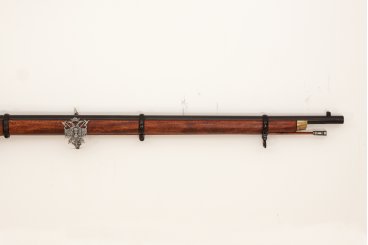

And the Enfield launches its projectile at just under 1000 feet per second. 45 ACP FMJ bullet weighs in at a measly 230 grains, or about half as much. Some of the minie balls I shoot weight 575 grains. 577 caliber minie balls bring at least 500 grains of pure soft-lead hurt when they hit home. I can only imagine how terrifying it must have been to stand in front of a rank of hundreds of men shooting rifled muskets at me–even more so when I think that.

I have repeatedly hit a six-foot by two-foot target at 300 yards with my Euro Arms copy, and would love to find a range long enough for me to stretch it out even farther.

With an 1853 Enfield, skilled riflemen could hit man-sized targets at 500 yards. Adherence to these outdated tactics contributed to shockingly high casualties in battle after battle with the rifled muskets. Unfortunately, neither the Union nor Confederate officer corps could easily put aside the Napoleonic tactics they learned at West Point, predicated on the relatively short range and inaccuracy of the old smoothbores. This spin made rifled muskets considerably more accurate over much longer distances than smoothbore muskets. When the powder charge behind the minie ball’s hollow base exploded, the hot gases forced the minie ball’s lead skirt to flare out and engage the rifling, creating a stabilizing spin. Because the minie ball had a diameter smaller than the bore, it dropped slickly down clean barrels, and could be easily rammed down barrels fouled with black powder residue from many previous shots. The old-school rifles used patched round balls that tightly fit the bore, and after only a few shots, they became impossible to reload until somebody swabbed out the fouling-not an easy task while folks are shooting at you or charging at you with fixed bayonets. Named the “minie ball” after its French military developer Claude Minie, this sub-caliber, conical lead bullet with a hollow base allowed troops to load their guns as rapidly as old-fashioned smoothbore muskets, but shoot with the accuracy of old-fashioned rifles. It was the projectile that made the rifled musket revolutionary. Usket?” Why didn’t they just call it a rifle or a musket? This type of weapon was termed a rifled musket because it loaded from the muzzle like the old smoothbore muskets, yet featured spiral grooves cut into the bore that made the projectile spin, hence “rifled.” 1862 when his unit exchanged their old Austrian Lorenz muskets for The NRA has an article about an 1853 Enfield carried and dropped at Gettysburg by Confederate infantryman J.A Fallin. 577 minie ball, the 1853 Enfield was issued by the hundreds of thousands by both sides, and was often regarded as the most accurate mass-issued rifled musket of the war. 1862 when his unit exchanged their old Austrian Lorenz muskets for “Enfields Rifles, which are a splendid gun.” So what the heck is a “rifled musket?ĭesigned to fire the.


 0 kommentar(er)
0 kommentar(er)
